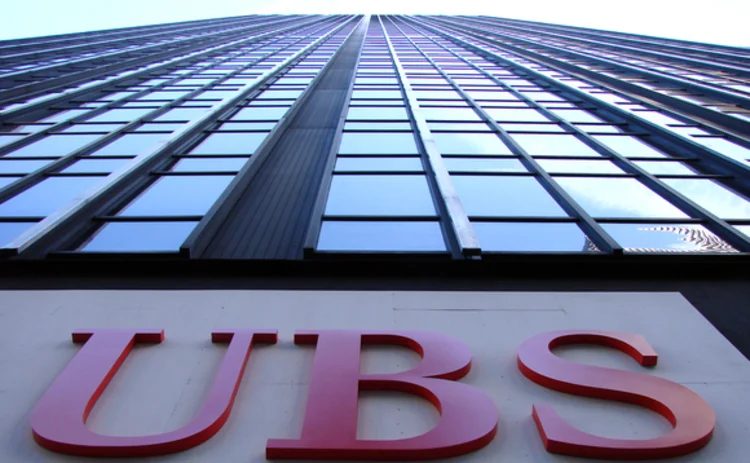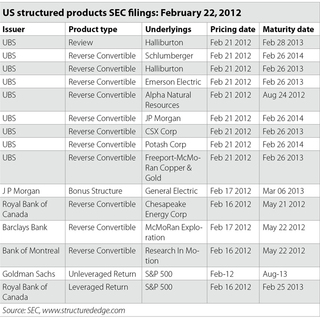
UBS leads reverse convertible flurry in the US
UBS registered nine reverse convertibles with the SEC on February 22. All the reverse convertibles registered on that date are based on single stocks from well-known US companies. JP Morgan offered a bonus structure, while Goldman Sachs and RBC chipped in with unleveraged and leveraged return notes, respectively

Reverse convertibles, notably from UBS, formed the majority of the structured products filed with the US Securities and Exchange Commission on February 22, with single stocks from big company names by far the most common underlyings. JP Morgan was the sole bank underlying, with Halliburton and Freeport-McMoran both the underlyings for two of the new products.
Of the 15 products filed with the Securities and Exchange Commission, UBS was the issuer for nine, with the remainder coming from JP Morgan, Royal Bank of Canada (two products), Barclays Bank, Bank of Montreal and Goldman Sachs.
Aside from reverse convertibles, products included a one-year bonus structure from JP Morgan that is linked to the stock of General Electric and offers a minimum return of 5.25% plus principal, provided the final-level 80% barrier is not breached. Returns are equal to the rise in the stock price, but only if this finishes above 105.25% of the initial level. The deal is capped at 120% on the upside.
Another non-reverse convertible product was the 1.01-year leveraged return note from Royal Bank of Canada, which is linked to the S&P 500 and offers the potential for accelerated returns of two times the growth in the index. Returns are capped at 115.9% and principal is at risk if the final level of the index is lower than 95% of the initial strike level.
Goldman Sachs offered an 18-month note on the same underlying, but with an unleveraged return. The potential return is equal to the rise in the index up to a maximum of 21–24.5% in addition to the principal amount, making the maximum annual return equivalent to 13.55–15.73% (compounded). Principal is at risk if the final level of the index is lower than 85% of the strike level.

Only users who have a paid subscription or are part of a corporate subscription are able to print or copy content.
To access these options, along with all other subscription benefits, please contact info@risk.net or view our subscription options here: http://subscriptions.risk.net/subscribe
You are currently unable to print this content. Please contact info@risk.net to find out more.
You are currently unable to copy this content. Please contact info@risk.net to find out more.
Copyright Infopro Digital Limited. All rights reserved.
You may share this content using our article tools. Printing this content is for the sole use of the Authorised User (named subscriber), as outlined in our terms and conditions - https://www.infopro-insight.com/terms-conditions/insight-subscriptions/
If you would like to purchase additional rights please email info@risk.net
Copyright Infopro Digital Limited. All rights reserved.
You may share this content using our article tools. Copying this content is for the sole use of the Authorised User (named subscriber), as outlined in our terms and conditions - https://www.infopro-insight.com/terms-conditions/insight-subscriptions/
If you would like to purchase additional rights please email info@risk.net
More on Structured products
A guide to home equity investments: the untapped real estate asset class
This report covers the investment opportunity in untapped home equity and the growth of HEIs, and outlines why the current macroeconomic environment presents a unique inflection point for credit-oriented investors to invest in HEIs
Podcast: Claudio Albanese on how bad models survive
Darwin’s theory of natural selection could help quants detect flawed models and strategies
Range accruals under spotlight as Taiwan prepares for FRTB
Taiwanese banks review viability of products offering options on long-dated rates
Structured products gain favour among Chinese enterprises
The Chinese government’s flagship national strategy for the advancement of regional connectivity – the Belt and Road Initiative – continues to encourage the outward expansion of Chinese state-owned enterprises (SOEs). Here, Guotai Junan International…
Structured notes – Transforming risk into opportunities
Global markets have experienced a period of extreme volatility in response to acute concerns over the economic impact of the Covid‑19 pandemic. Numerix explores what this means for traders, issuers, risk managers and investors as the structured products…
Structured products – Transforming risk into opportunities
The structured product market is one of the most dynamic and complex of all, offering a multitude of benefits to investors. But increased regulation, intense competition and heightened volatility have become the new normal in financial markets, creating…
Increased adoption and innovation are driving the structured products market
To help better understand the challenges and opportunities a range of firms face when operating in this business, the current trends and future of structured products, and how the digital evolution is impacting the market, Numerix’s Ilja Faerman, senior…
Structured products – The ART of risk transfer
Exploring the risk thrown up by autocallables has created a new family of structured products, offering diversification to investors while allowing their manufacturers room to extend their portfolios, writes Manvir Nijhar, co-head of equities and equity…
Most read
- Top 10 operational risks for 2024
- The American way: a stress-test substitute for Basel’s IRRBB?
- Filling gaps in market data with optimal transport







